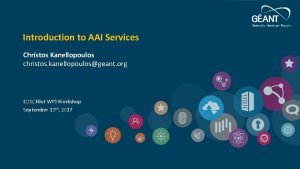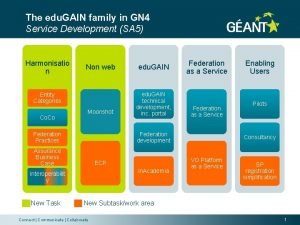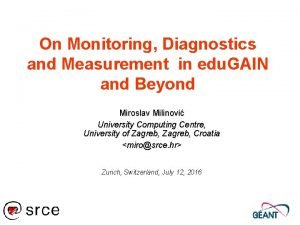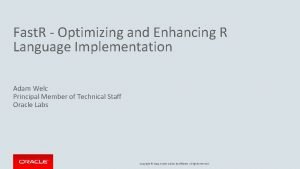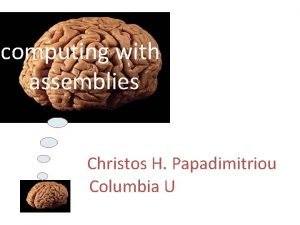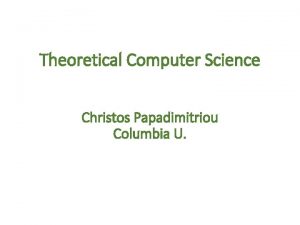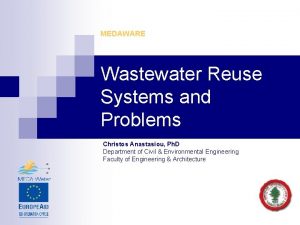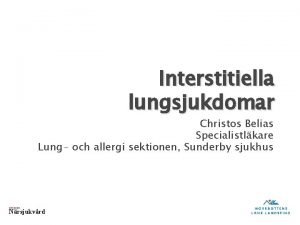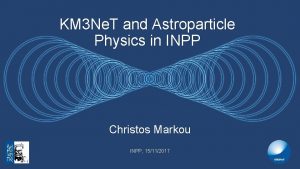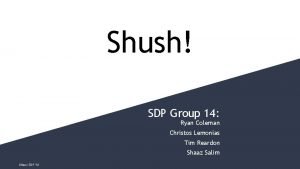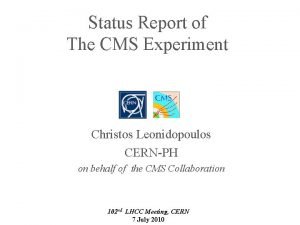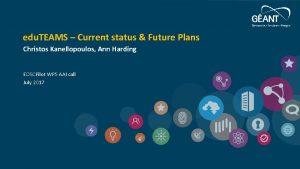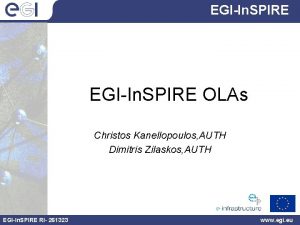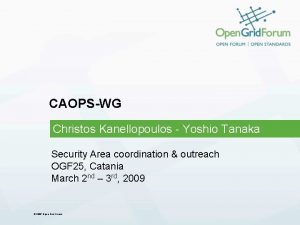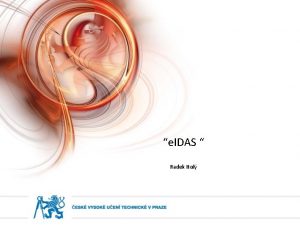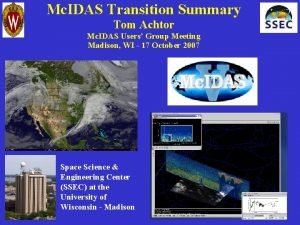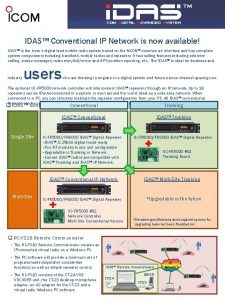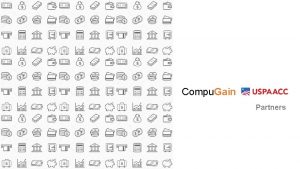Update on e IDAS Christos Kanellopoulos edu GAIN













- Slides: 13

Update on e. IDAS Christos Kanellopoulos edu. GAIN Town. Hall, Vienna February 21 st, 2017 Networks ∙ Services ∙ People www. geant. org

Background information • 23 JUL 2014 Adoption of e. IDAS regulation • 29 SEP 2015 Voluntary recognition of e. ID means • EARLY 2016 e. ID Interoperability Infrastructure available under Connecting Europe Facility (CEF) • 1 JULY 2016 Trust Service rules apply and voluntary use of EU Trust Mark is available • 29 SEP 2018 Cross-border recognition of e. ID means Networks ∙ Services ∙ People www. geant. org 2

Use cases 1. The use of e. IDAS e. IDs in the context of academic research services. The use case scenario is a researcher participating in an international collaboration, who will be accessing services available in edu. GAIN using e. IDAS e. ID assertions as a means of identifying herself. There is an important benefit here for edu. GAIN as there are cases in which researchers do not have e. IDs from an academic institution but may have access to national e. ID through e. IDAS 2. The use of e. IDAS as a mean to access services that require higher Lo. A The use case scenario is a researcher participating in an international collaboration (e. g. a Bio-bank), who will be accessing services available in edu. GAIN using e. IDAS e. ID assertions as a mean to elevate the Lo. A of the identity assertion. This is an existing problem for edu. GAIN as there are no higher levels of assurance currently. 3. The combination of e. IDAS e. ID assertions and user attributes coming from a university The use case scenario will mimic the user journey of an individual registering at a university in country B (e. IDAS e. ID assertion- from IDPs) and asserting proof of their academic attributes from an institution in country A (attribute enrichment). The user will register to enrol at a university in country A by asserting an identity and additional attributes established in country B. It is noted that the US does not currently have a national e. ID service meaning that **this element of the alpha will focus on user research rather than technical implementation aspects**. Networks ∙ Services ∙ People www. geant. org 3

Cross-sector interoperation with e. IDAS • 2016 -07 – 1 st meeting in Brussels between AARC, GN 4 and e. IDAS Reps • Investigate the possibility of an interoperation pilot between edu. GAIN and e. IDAS • 2016 -09 – 2 nd meeting in London (AARC, GN 4, Internet 2, e. IDAS Reps) • Draft proposal for an interoperability pilot between • 3 Use cases: • Use case 1: authenticate to edu. GAIN service with e. IDAS e. ID • Use case 2: authentication to an edu. GAIN service where a higher Lo. A is required • Use case 3: registering at a university online with cross-border attribute provision [** This use case is only going to be a study and not an actual implementation ] • 2016 -10 – edu. GAIN Steering Group • Internal analysis and recommendation on the interoperation scenarios: • Establish bridge/proxy at the national level? • A distributed bridge/proxy at the GÉANT/edu. GAIN level? • e. IDAS as an Identity Federation in edu. GAIN? Networks ∙ Services ∙ People www. geant. org 4

edu. GAIN – e. IDAS Comparison - https: //goo. gl/t. Lb. XE 4 C. Kanellopoulos/AARC - GN 4, Licia Florio/GÉANT – AARC, Maarten Kremers/SURFNET – GN 4, Wolfgang Pempe/DFN, Davide Vaghetti/GAAR, Ioannis Kakavas/GRNET, Nicolas Liampotis/GRNET Networks ∙ Services ∙ People www. geant. org 5

edu. GAIN – e. IDAS Comparison - https: //goo. gl/t. Lb. XE 4 edu. GAIN • Architecture • Dynamic topology (proxied and full mesh federations • Id. Ps and SPs published in edu. GAIN MDS e. IDAS • Architecture • “Static” topology (proxies) • Static trust relationship between e. IDAS Nodes • Service Providers • Requested attributes in the metadata • Service Providers • Requested attributes in Auth. N request • SPType: Private or Public • Attributes • edu. Person • Attributes Networks ∙ Services ∙ People www. geant. org • Surname, Name, Date of Birth, Unique Identifier, First name at birth, Family name at birth, Place of birth, Current address, Gender 6

edu. GAIN – e. IDAS Comparison - https: //goo. gl/t. Lb. XE 4 edu. GAIN e. IDAS • SAML Auth. N Request • Dynamic topology (proxied and full mesh federations • Request. Authn. Context MAY be set and comparison attribute SHOULD NOT me provided or be set to “exact" • SAML Auth. N Request • Force auth must be set to True • SPType must be set to Public or Private <eidas: SPType> • Requested attributes <eidas: Requested. Attributes> • Request. Authn. Context MUST be set and comparison attribute MAY be provided • SAML Auth. N Response • MUST be signed • Unsolicited responses MUST be accepted Networks ∙ Services ∙ People www. geant. org • MAY be signed • Unsolicited responses MUST NOT be accepted 7

Interoperability Scenarios • Scenario 1: A service with global scope that would function as a gateway between any entity in the edu. GAIN inter-federation and the e. IDAS Network • Scenario 2: An implementation with national scope that would function as a “gateway” between the national academic federation and the e. IDAS-Node in the specific country. Networks ∙ Services ∙ People www. geant. org 8

Interoperability Scenarios | Scenario 1 Networks ∙ Services ∙ People www. geant. org 9

Interoperability Scenarios | Scenario 1 • Taps directly to e. IDAS Interoperability Framework, which is the only common standardized interface across all the national e. ID schemes • Just one service for all the federations participating in edu. GAIN • No extra burden to the federation operators • SPs can treat the service as a proxy Id. P • Flexibility on how e. IDAS becomes visible to the federations • Avoid creating islands in which some federation will be able to use the local e. GOV ID scheme, while there is no support in others • SPs worldwide could potentially benefit from such a bridge • Not under the direct control of each Federation • Has to be operated as an edu. GAIN service • Increased burden (and possible liability) for the organization(s) operating the service • e. IDAS is a European specific service, why should federations outside of Europe care about this? Networks ∙ Services ∙ People www. geant. org 10

Interoperability Scenarios | Scenario 2 Networks ∙ Services ∙ People www. geant. org 11

Interoperability Scenarios | Scenario 2 • Tailored to the needs of each federation • Fully controlled by the federation • The burden and liability of the implementation is distributed to the federations • The implementation could be more lightweight for some cases • Each implementation would be specific to each country • Dependency on the willingness or the reluctancy of each country’s e. GOV ID governance to accomplish the integration with the local R&E identity federation • Extra burden (and possibly costs) on the operators of the federation Networks ∙ Services ∙ People www. geant. org 12

skanct@gmail. com Thank you and any questions Networks ∙ Services ∙ People www. geant. org 13
